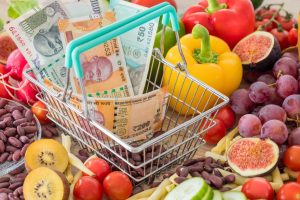24 Sep Inflation in a time of low income and reduced demand (GS 3, Economics, The Hindu, Indian Express, PIB)
During the period of high inflation people consume less, essentially if their income is not increasing or reducing. It will be very difficult for them to manage the Essentials like food and shelter in the same amount as earlier. It affects their standard of living. The aggregate demand during the period of high inflation comes down. It pulls down the aggregate supply as producers would not be interested Producing more in case of low demand. In this case they would be firing people out of the job. Unemployment will increase. It further Decreases the aggregate demand as people are losing their jobs. Hence the GDP goes down when Unemployment rate goes up.
Covid and Inflation: In case of covid-19 the inflation was high due to short supply/production as there was stringent lockdown across the country. The reduction in production/supply resulted in unemployment and that’s why reduced demand. Now if inflation prevails in a time of low income (unemployment) and reduced demand, the economy faces a vicious cycle of inflation and low growth.
Hence cost push inflation would be more difficult to manage than demand pull inflation. Here the solution is to boost the production activity and get it to the pre-covid level at least. Government needs to put money in the economy to increase aggregate demand and incentivize the production activity in many ways such as lowering the taxes, giving subsidies, providing cheap loans, interest subvention, moratorium on repayment, etc.
Measuring Inflation during lock down: Inflation measurement: Inflation is generally measured as weighted average percentage increment in the price of commodities kept in a basket. Data availability is core in calculating Inflation as you can calculate the increment in the prices for any month only if you have the data of prices of the same month of the previous year. Last year (2020) the data on production and prices for the months April to July could not be collected due to stringent lockdown. The current data on prices for April to July 2021 cannot be compared with prices for the same months of 2020. Hence if we look into inflation for said months, It would not be reflecting the actual picture.
Concerns: The inflation for the month of June in respect of wholesale price index (WPI) has been above 10% and consumer price index (CPI) crossed the 6% mark, which was above the Reserve Bank of India (RBI)’s tolerance band. The target band of inflation for RBI is kept as 4 +/- 2% of CPI(combined), Means the RBI should control the inflation between 2 to 6% but trying to keep it around 4%. consumer price index (CPI) and wholesale price index (WPI) are baskets of commodities in which price increment is measured. The basket of WPI has the commodities with respect to the producers, hence inflation of WPI is for producers. The basket of CPI has the commodities which generally a consumer consumes so the CPI inflation is for the consumer. Consumers are also categorised as urban consumers and rural consumers because the basket of consumption of urban consumers will be different from the basket of consumption of rural consumers. accordingly it is called CPI Urban and CPI rural. CPI combined is also measured by taking the average of CPI Urban and CPI rural.
For the calculation of inflation for a month, the average percentage increment in the prices of commodities kept in any of the said basket is taken by comparing the prices for the same month of the previous year. For example if you are calculating the inflation for the month of July 2021 , you need to calculate the average percentage increment of prices by comparing with the prices for July 2020. It is called “year on year inflation” (YOY). Now supposedly in this example only if you could not collect the data of prices for the month of July 2020 then it is going to be very difficult to calculate inflation for the month of July 2021. This is what happened for the months of April to July 2020 due to stringent lockdown. The government Agencies responsible for the measurement of inflation could not manage the data during lockdown periods. Now if we have the inflation figure for the month of April to July 2021 it raises concerns whether the inflation figure is showing the actual picture. At the same time the weightage of the commodities kept in the basket of CPI would not be reflecting the actual weightage of consumption by people because of the reduced income and demand. We have witnessed the reduction in the consumption of essential items like food and fuel. The weightage of commodities taken in the basket reflects the weightage of consumption during normal days but not for the days of Covid and lockdown. This also raises concerns whether figures of CPI or WPI are reflecting the actual effect of inflation.
Way forward: This is the time when the government needs to put money in the economy and lower the direct taxes so as to increase aggregate demand. It needs to incentivize the production activity in every possible ways such as lowering the indirect taxes, giving subsidies, providing cheap loans, interest subvention, moratorium on repayment, etc.
Md Layeeque Azam, Economics Faculty
24nd september 2021 current Affairs Download
Plutus IAS Current Affair Team Member




No Comments